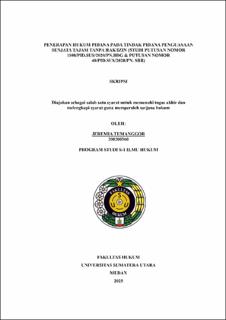Penerapan Hukum Pidana pada Tindak Pidana Penguasaan Senjata Тајаm Tanpa Hak/Izin (Studi Putusan Nomor 1108/PID.SUS/2020/PN.BDG & Putusan Nomor 40/PID.SUS/2020/PN. SBR)
Application of Criminal Law on The Criminal Act of Possession of A Sharp Weapon Without Rights/Permit (Study of Decision Number 1108/PID.SUS/2020/PN.BDG & Decision Number 40/PID.SUS/2020/PN.SBR)

Date
2025Author
Tumanggor, Jeremia
Advisor(s)
Lubis, Rafiqoh
Nasution, Eva Syahfitri
Metadata
Show full item recordAbstract
The evidentiary process is the main aspect in the examination of cases in court. It is through this evidentiary stage that the process, methods, and actions take place to show the rightness or wrongness of the defendant in relation to a criminal case in a court session. In the process of proof, the Public Prosecutor, Legal Counsel, and the Panel of Judges presiding over the examination of criminal cases at trial must pay attention to the laws and regulations governing the procedure of proof, the burden of proof, the types of evidence, as well as the value of the legal force of each evidence submitted, and other related matters so as not to cause errors at the time of sentencing the defendant. This thesis contains several problem formulations, namely as follows: 1) How is the regulation of criminal law on the criminal act of possession of sharp weapons without rights / permits; 2) How is the relationship between proving the elements of a criminal act and the criminal liability of the perpetrator of a criminal act; 3) How is the judge's consideration of the crime of possession of sharp weapons without rights / permits in verdict number 1108/Pid.Sus/2020/Pn. Bdg & Decision Number 40/Pid.Sus/2020/Pn.Sbr.The research method in writing this thesis uses a descriptive normative juridical method. The data collection used in writing this thesis is the library research method, with the main data sources including primary, secondary, and tertiary legal materials. The data analysis method used in writing this thesis uses qualitative methods and deductive inference methods. The results of this research conclude that the criminal act of possession of sharp weapons without rights or permits is regulated in Article 2 of Emergency Law No. 12 of 1951. However, there are still errors in proving the elements of the type of sharp weapon that requires a license, which causes the article charged by the public prosecutor to be inappropriate for the defendant. As in Decision Number 40/Pid.Sus/2020/Pn.Sbr which charged the defendant with Article 2 of Emergency Law Number 12 of 1951, where the sharp weapon used by the defendant was not a sharp weapon that required a license as referred to in Article 2 paragraph (2) of Emergency Law Number 12 of 1951.
Collections
- Undergraduate Theses [2776]
